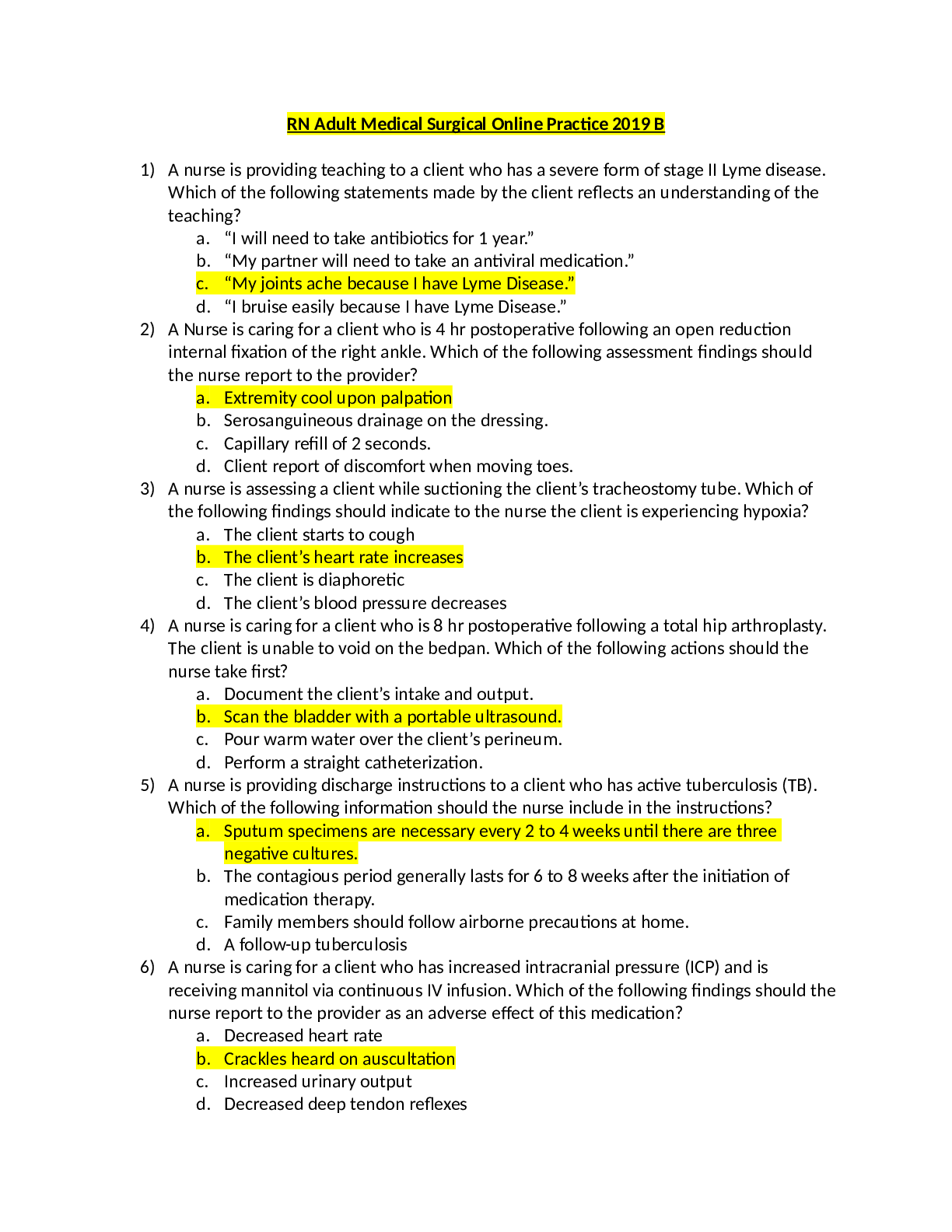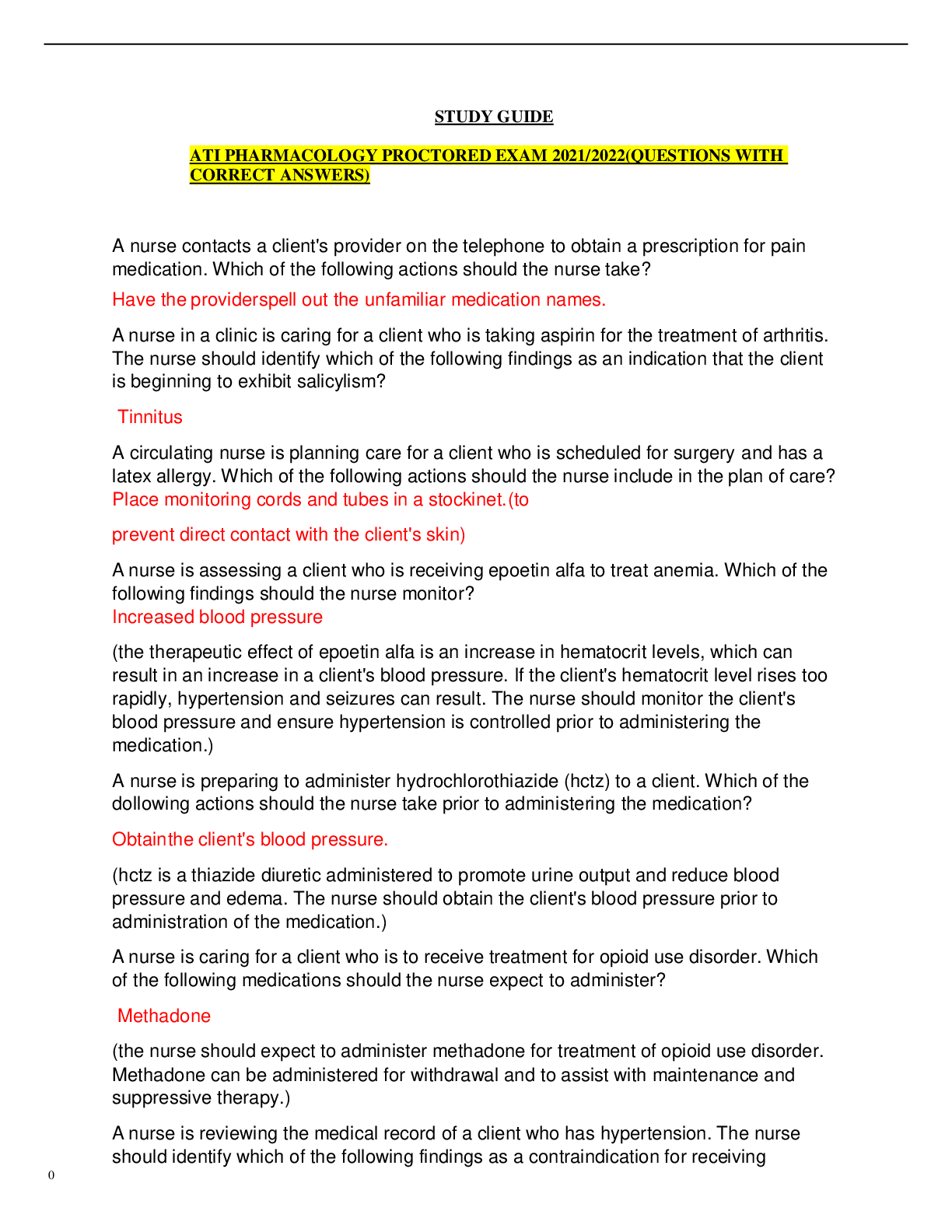Health Care > EXAM > RN Adult Medical Surgical Online Practice 2019 B| RN Adult Medical Surgical Online Practice 2019 B w (All)
RN Adult Medical Surgical Online Practice 2019 B| RN Adult Medical Surgical Online Practice 2019 B with options
Document Content and Description Below
RN Adult Medical Surgical Online Practice 2019 B| RN Adult Medical Surgical Online Practice 2019 B with options A nurse is assessing for compartment syndrome in a client who has a short leg cast. Whi... ch of the following findings should the nurse identify as a manifestation of this condition? Correct Answer: Pain that increases with passive movement Rationale: The nurse should identify that a client who has compartment syndrome experiences pain that increases with passive movement. Compartment syndrome results from a decrease in blood flow in the extremity caused by a decrease in the muscle compartment size due to a cast that is too tight. A nurse is providing teaching to a client who has a severe form of stage II Lyme disease. Which of the following statements made by the client reflects an understanding of the teaching? Correct Answer: My joints ache because I have Lyme disease Rationale: Lyme disease is a vector-borne illness transmitted by the deer tick. The disease course occurs in three stages beginning with joint and muscle pain in stage I. If left untreated, these symptoms continue throughout stage II and, by stage III, become chronic. Other chronic complications include memory problems and fatigue. A nurse is preparing to administer phenytoin 600 mg PO daily to a client. The amount available is oral solution 125 mg/5 mL. How many mL should the nurse administer? (Round the answer to the nearest whole number. Use a leading zero if it applies. Do not use a trailing zero.) Correct Answer: 24 A nurse is caring for a client who has an arterial line. Which of the following actions should the nurse take? Correct Answer: place a pressure bag around the flush solution Rationale: The nurse should place a pressure bag around the flush solution of 0.9% sodium chloride because the pressure from an artery is greater than that of the line. An arterial line is not appropriate access for administering antibiotics. The nurse should use the arterial line to obtain arterial blood gas samples and monitor hemodynamic pressures. A nurse is updating the plan of care for a client who is receiving chemotherapy. Which of the following findings should the nurse identify as the priority? Correct Answer: Report of sore throat Rationale: When using the urgent vs. nonurgent approach to client care, the nurse should determine that the priority finding is a report of a sore throat, which could be a manifestation of an infection. The client is at risk for neutropenia due to myelosuppression; therefore, an infection could lead to sepsis. A nurse is reviewing the medical record of a client who has systemic lupus erythematosus (SLE). Which of the following findings should the nurse expect? Correct Answer: Facial butterfly rash Rationale: A butterfly rash is a manifestation of SLE. It appears as a dry, red rash on the client's cheeks and nose and can disappear during times of remission. A nurse is planning care for a client who is postoperative following a parathyroidectomy. Which of the following actions should the nurse identify as the priority? Correct Answer: Place tracheostomy tray at the bedside Rationale: The priority action the nurse should take when using the airway, breathing, circulation approach to client care is to place a tracheostomy tray at the client's bedside in case of airway obstruction. A nurse is assessing a client who has diabetes insipidus. Which of the following findings should the nurse expect? Correct Answer: Low urine specific gravity Rationale: An expected finding for a client who has diabetes insipidus is a urine specific gravity between 1.001 and 1.005. Decreased water reabsorption by the renal tubules is caused by an alteration in antidiuretic hormone release or the kidneys' responsiveness to the hormone. A nurse is providing teaching to a client who has stage II cervical cancer and is scheduled for brachytherapy. Which of the following instructions should the nurse include? Correct Answer: You will need to stay still in the bed during each treatment session." Rationale: The nurse should instruct the client that they will need to remain on bed rest with very limited movement because excessive movement can cause the radioactive source to become dislodged. The nurse should instruct the client that there is not excreted radiation between treatments. The nurse should instruct the client that there will likely be between two and five treatments, once or twice each week. The nurse should instruct the client that blood in the urine is an adverse effect of brachytherapy and is not an expected finding. A nurse is planning care for a client who is scheduled for a thoracentesis. Which of the following interventions should the nurse include in the plan? Correct Answer: Encourage the client to take deep breaths after the procedure. Rationale: After a thoracentesis, the client should deep breathe to re-expand the lung. A nurse is caring for a client who is receiving a blood transfusion. The client becomes restless, dyspneic, and has crackles noted to the lung bases. Which of the following actions should the nurse anticipate taking? Correct Answer: Slow the infusion rate Rationale: Dyspnea, restlessness, and the onset of crackles during a blood transfusion are manifestations of circulatory overload. The nurse should slow or stop the infusion to improve the client's ability to breathe, place the client in an upright position, and notify the provider. The provider might prescribe a diuretic to alleviate the fluid overload. A nurse is providing teaching to a client who has end-stage kidney disease and is waiting for a kidney transplant. Which of the following information should the nurse provide? Correct Answer: Hemodialys is something required following surgery. Rationale: When a kidney comes from a deceased donor, it might not function immediately, requiring the recipient to continue hemodialysis postoperatively. A nurse is caring for a client who has hypothyroidism. Which of the following manifestations should the nurse expect? Correct Answer: Constipation Rationale: A client who has hypothyroidism can experience constipation due to the decrease in the client's metabolism, resulting in slow motility of the gastrointestinal tract. The nurse should instruct the client to increase fiber and fluid intake to reduce the risk for constipation. A nurse is providing preoperative teaching for a client who is scheduled for a mastectomy. Which of the following statements should the nurse make? Correct Answer: I will refer you to community resources that can provide support. Rationale: The nurse should provide the client with support resources, including community programs, to assist the client with acceptance of body image changes. A nurse is caring for a client who had a nephrostomy tube inserted 12 hr ago. Which of the following findings should the nurse report to the provider? Correct Answer: Client reports back pain Rationale: The nurse should notify the provider if the client reports back pain, which can indicate that the nephrostomy tube is dislodged or clogged. A nurse is teaching a family about the care of a parent who has a new diagnosis of Alzheimer's disease. Which of the following information should the nurse include in the teaching? Correct Answer: Create complete outfits and allow the client to select one each day Rationale: The family should place completed outfits on hangers and allow the client to select which one to wear each day. A nurse is caring for a client who has breast cancer and tells the nurse that they would like to have acupuncture because it provides greater relief than pain medication. Which of the following statements should the nurse make? Correct Answer: "I can speak to the provider about incorporating acupuncture into your treatment plan." Rationale: The nurse should serve as an advocate for the client by acting on behalf of the client and offering to speak with the provider. The client has the right to make choices and decisions about their treatment and the nurse should support these decisions and assist the client to carry them out. A nurse is caring for a client following extubation of an endotracheal tube 10 min ago. Which of the following findings should the nurse report to the provider immediately? Correct Answer: Stridor Rationale: Using the urgent vs. nonurgent approach to client care, the nurse should determine that the priority finding is stridor. Stridor can indicate a narrowing airway or possible obstruction caused by edema or laryngeal spasms. The nurse should report the finding immediately and implement an intervention. A nurse is reviewing the laboratory findings of a client who developed chest pain 6 hr ago. The nurse should identify which of the following findings as an indication of a myocardial infarction (MI)? Correct Answer: Troponin I 8 ng/mL Rationale: Troponins are proteins present in skeletal and cardiac muscle that are involved with muscle contraction. The elevation of either troponin T or troponin I is an indication of cardiac injury. The client's laboratory value is above the expected reference range for troponin I, indicating an MI has occurred. A nurse is preparing to administer a blood transfusion to a client who has anemia. Which of the following actions should the nurse take first? Correct Answer: Check for the type and number of units of blood to administer Rationale: According to evidence-based practice, the nurse should first confirm that the type and number of units of blood to administer matches what is indicated in the client's medication administration record. A nurse is reviewing the laboratory results of a client who has aplastic anemia. Which of the following findings indicates a potential complication? Correct Answer: WBC count 2,000 Rationale: A WBC count of 2,000/mm3 is below the expected reference range and indicates a risk for severe immunosuppression. A nurse is providing discharge teaching to a client who is postoperative following a modified radical mastectomy. Which of the following instructions should the nurse include? Correct Answer: Numbness can occur along the inside of the affected arm. Rationale: The nurse should instruct the client that numbness can occur near the incision and along the inside of the affected arm due to nerve injury. [Show More]
Last updated: 1 year ago
Preview 1 out of 16 pages

Buy this document to get the full access instantly
Instant Download Access after purchase
Add to cartInstant download
We Accept:

Reviews( 0 )
$18.00
Document information
Connected school, study & course
About the document
Uploaded On
Sep 13, 2022
Number of pages
16
Written in
Additional information
This document has been written for:
Uploaded
Sep 13, 2022
Downloads
0
Views
67


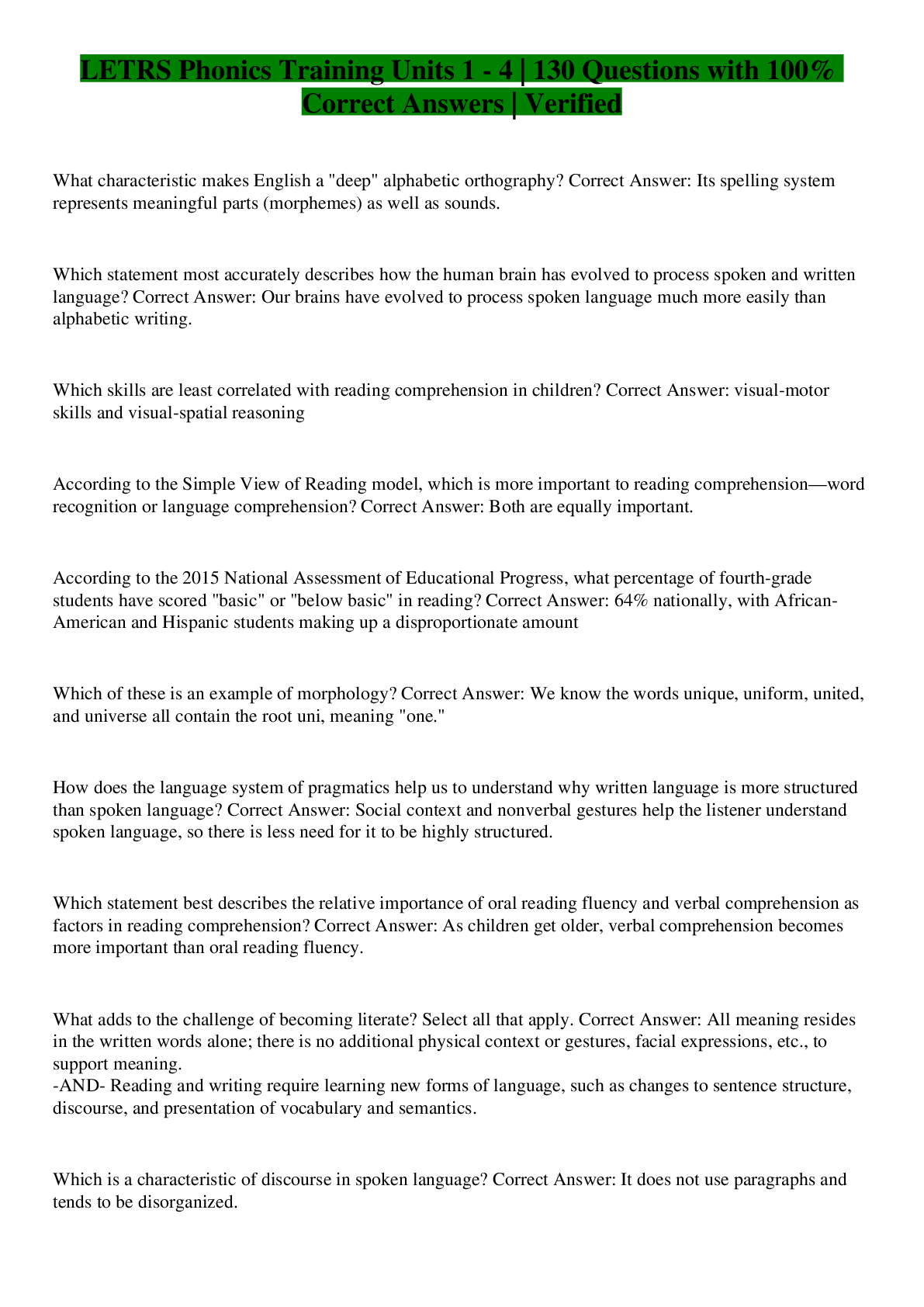
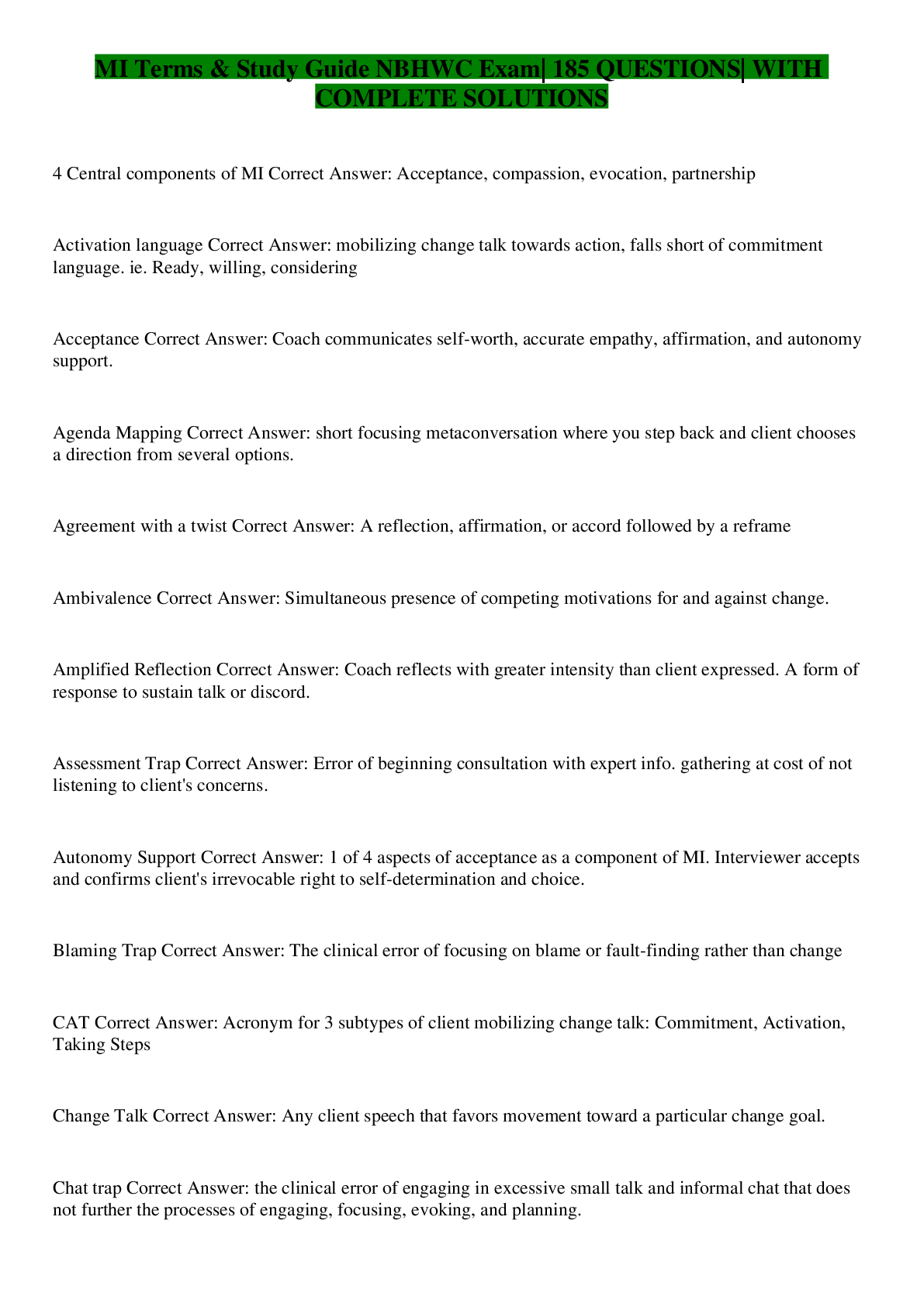
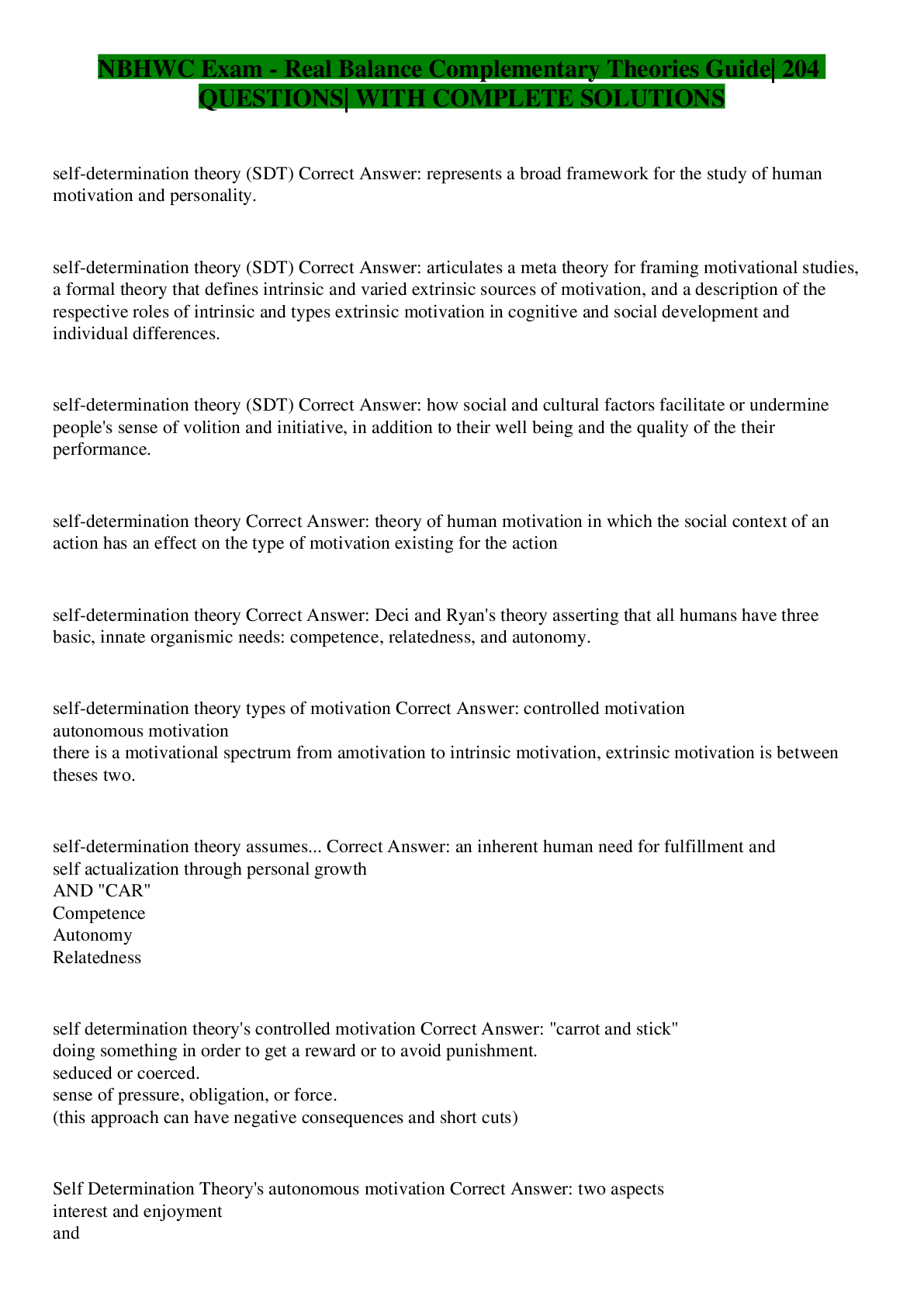
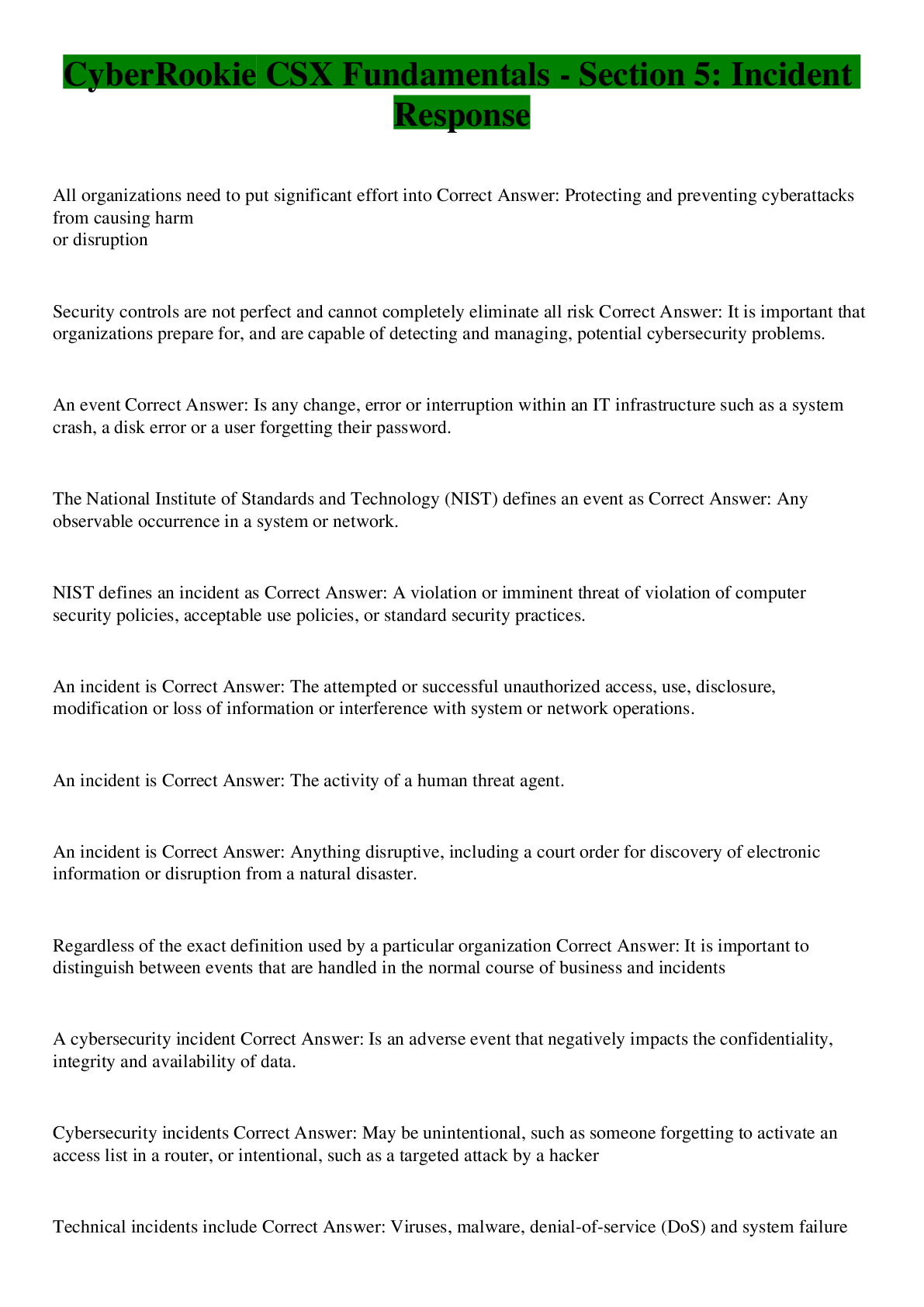
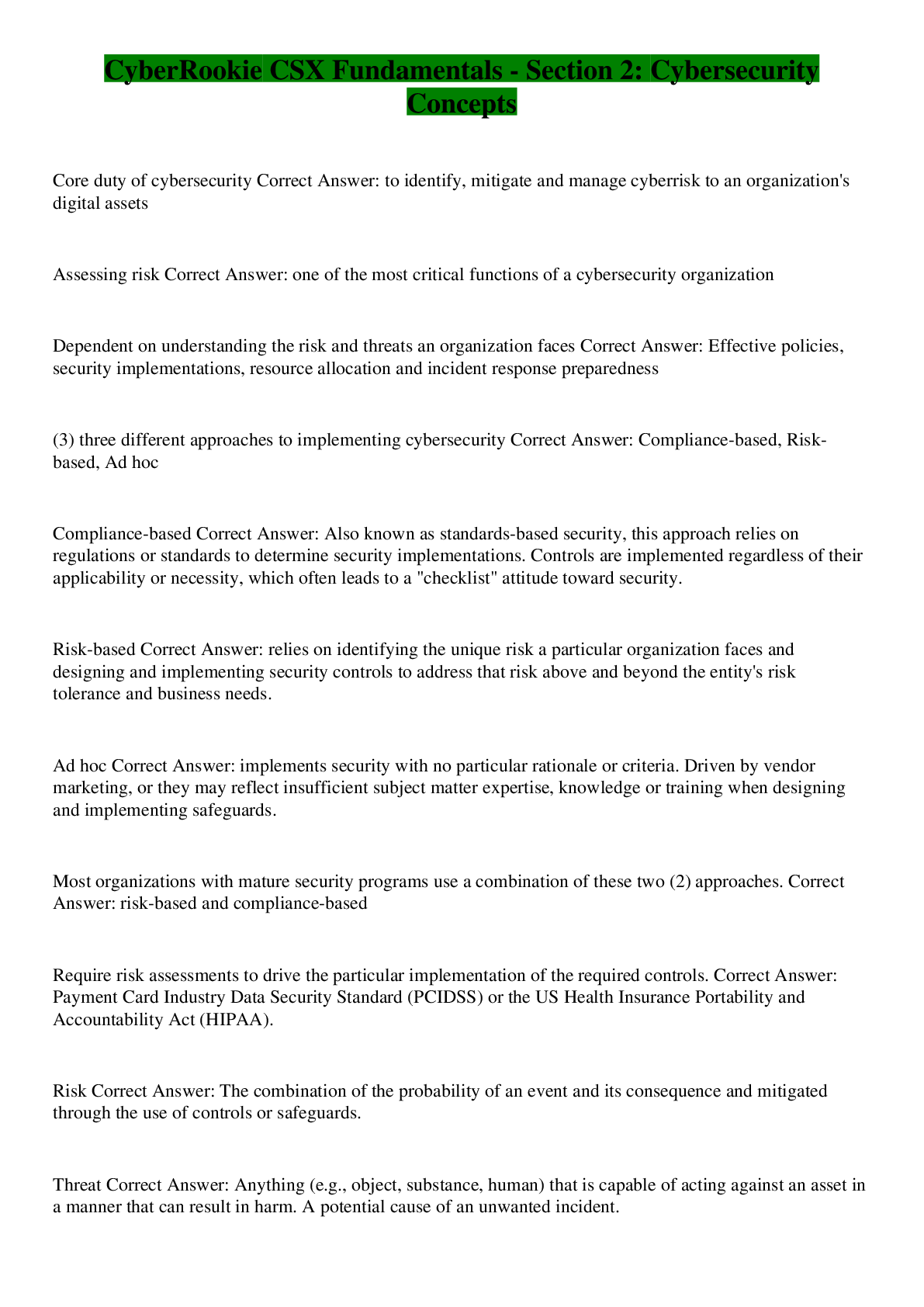
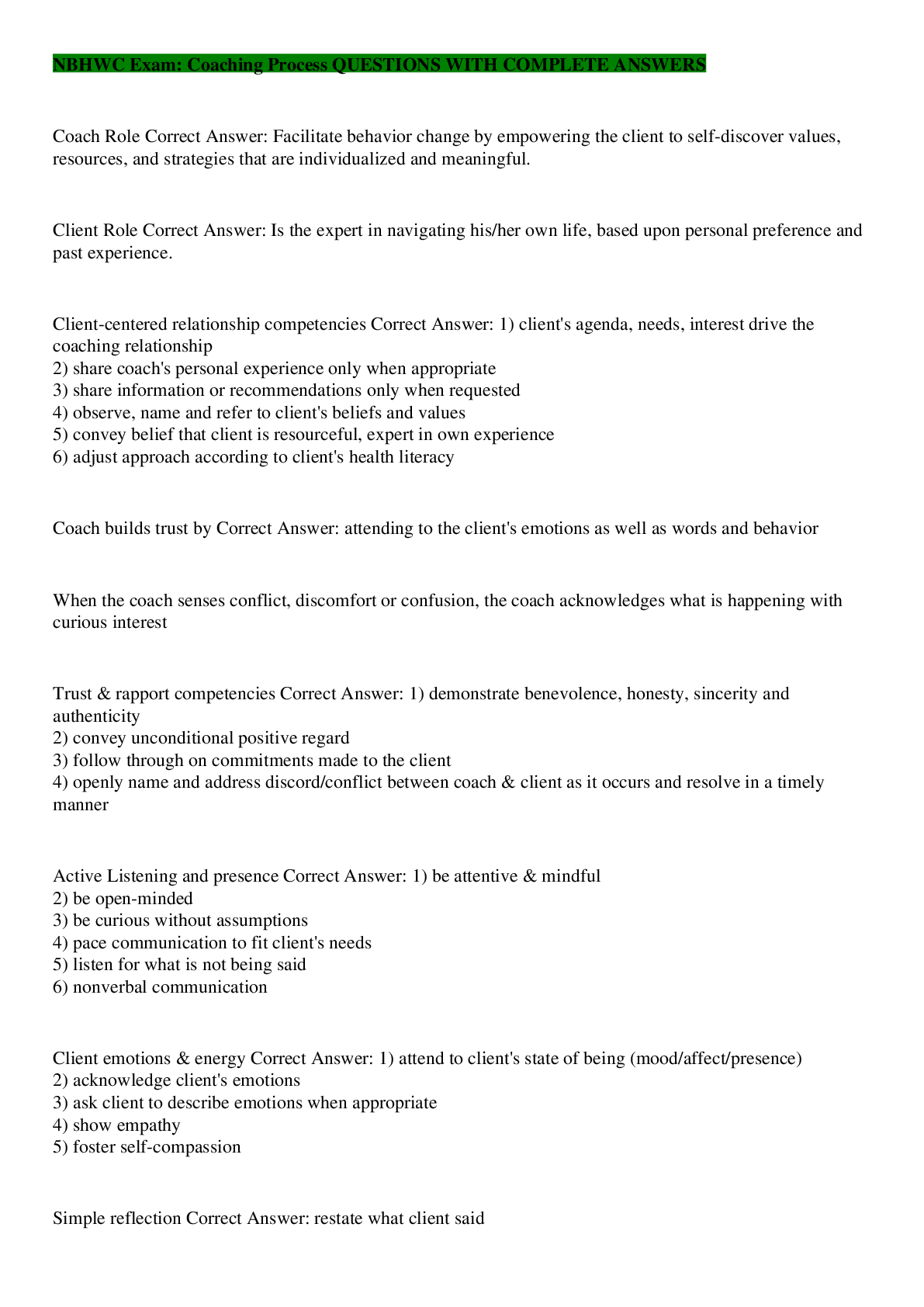




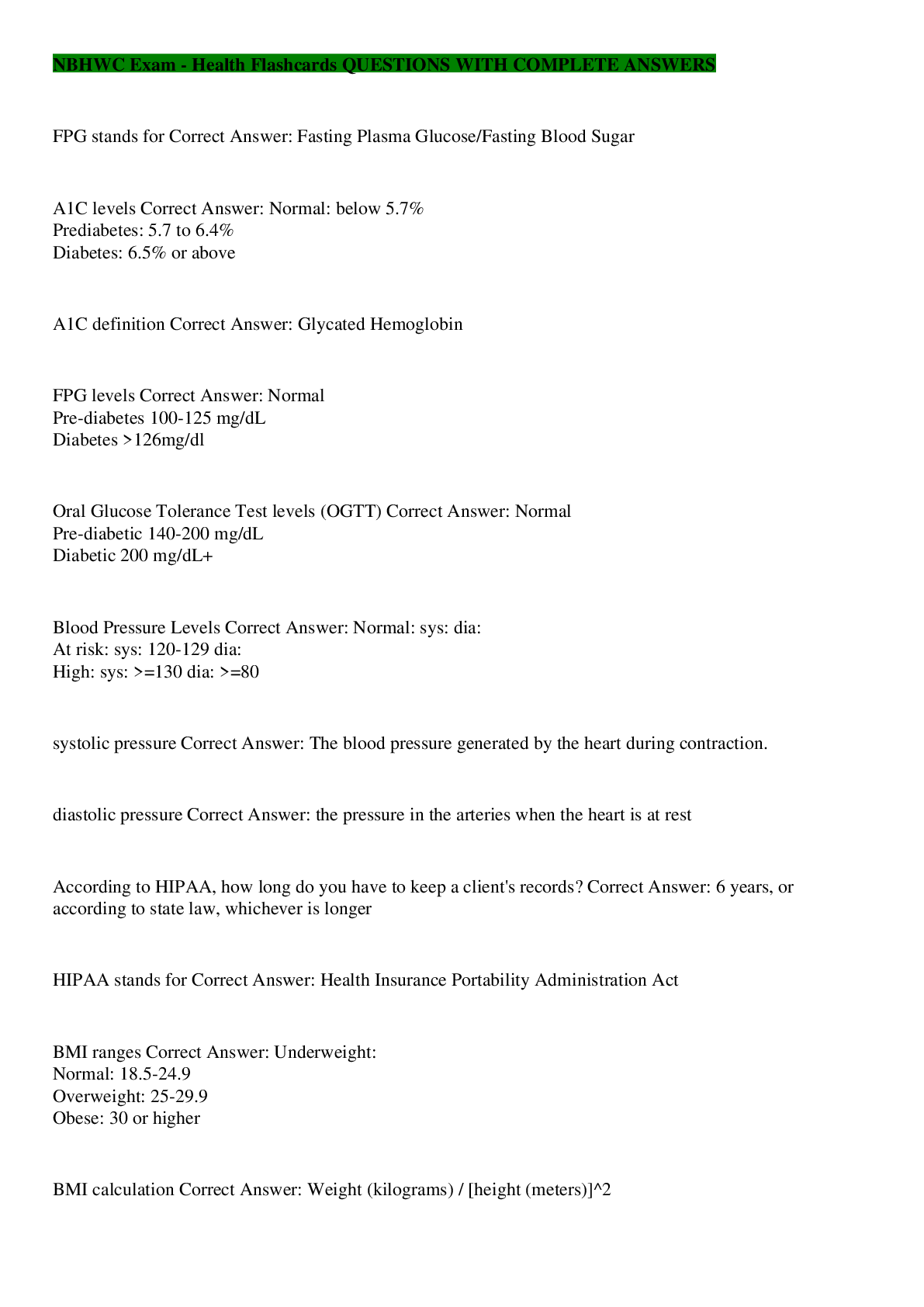
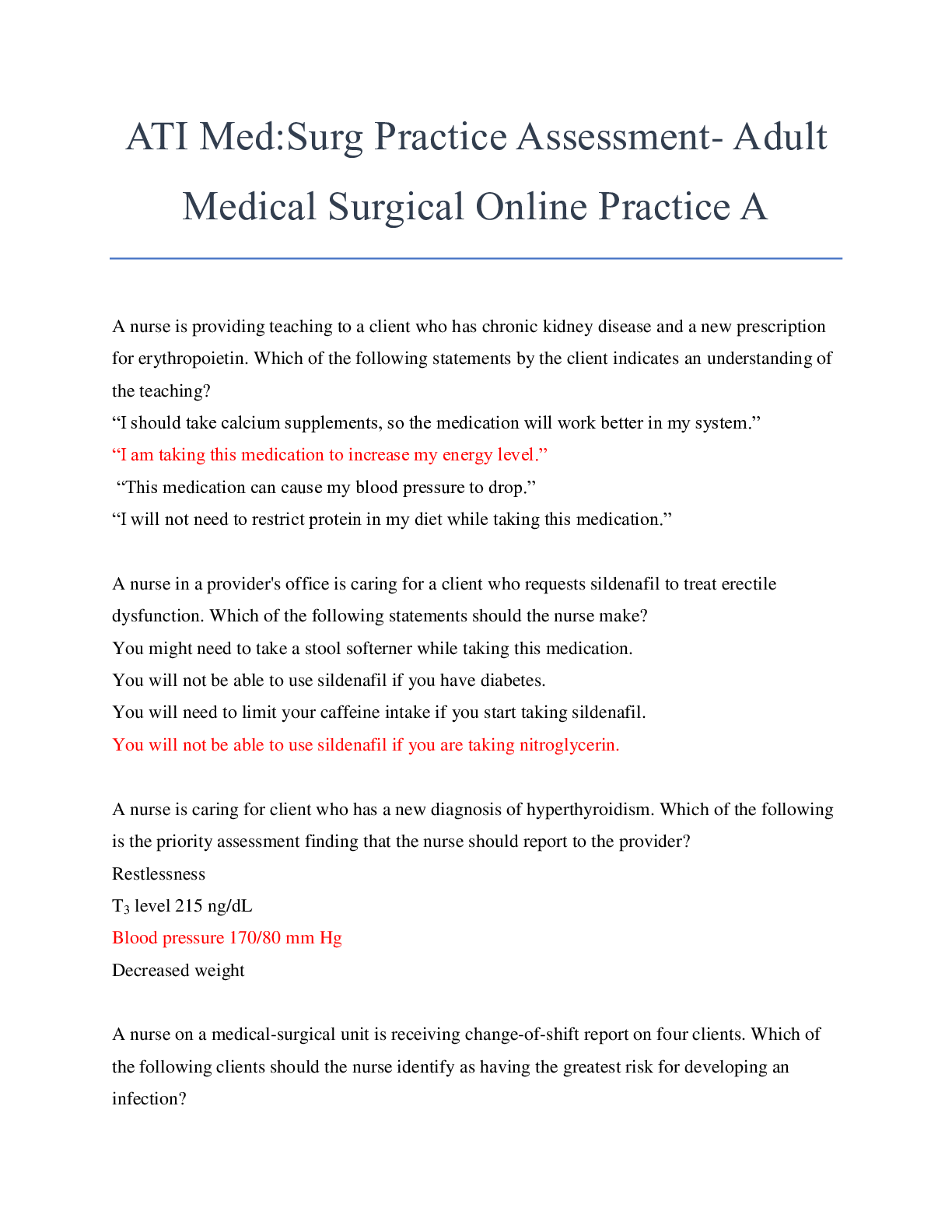
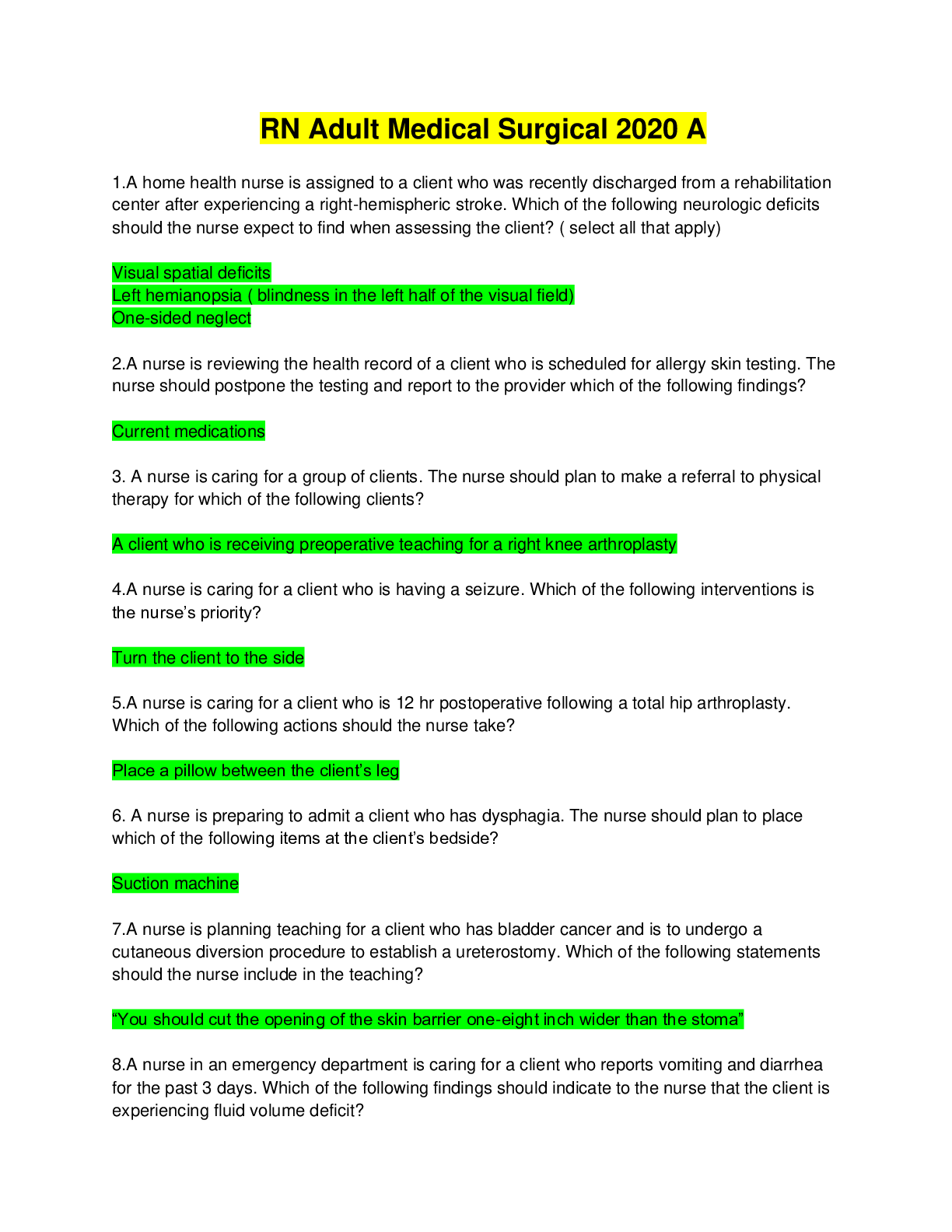



.png)
.png)

